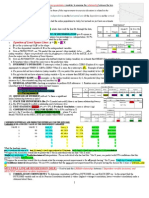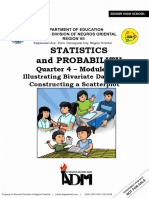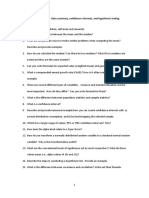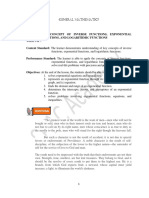Stats and Probability
Uploaded by
Genymaer CarbajosaStats and Probability
Uploaded by
Genymaer Carbajosa11
Republic of the Philippines
Department of Education
NATIONAL CAPITAL REGION
Misamis Street, Bago-Bantay, Quezon City
UNIFIED SUPPLEMENTARY LEARNING MATERIALS
(USLeM)
STATISTICS AND PROBABILITY
Quarter 4 Week 9-10
DEVELOPMENT & EDITORIAL TEAM:
Writer: Diana Jane A. Alfaro
SDS: Margarito B. Materum SDO EPS (Math): Mirasol I. Rongavilla
CID Chief: Ellery G. Quintia SDO LR: Daisy L. Mataac
This is a Government Property. Not for Sale
UNIFIED SUPPLEMENTARY LEARNING MATERIALS
Grades 11 Statistics and Probability
LESSON 1: Exploring Regression Analysis
EXPECTATIONS
After exploring this supplementary learning material, you should be able to:
1. identify the independent and dependent variables;
2. calculate the slope and y-intercept of the regression line
3. interpret the calculated slope and y-intercept of the regression line
4. predict the value of the dependent variable given the value of the independent
variable.
5. solve problem involving regression analysis.
Pretest
For numbers 1-5. Identify the variable, calculate the slope and y-intercept and
then interpret the result.
Lisa and her friends are going on vacation to Boracay which is 430 kilometer
away from Manila. To pass the time, she recorded the hours spent in driving and the
distance traveled.
Hours Traveled Distanced Traveled
1 85
2 100
3 125
4 150
5 200
6 230
7 280
1. Identify the Independent and dependent variable.
2. What is the slope?
3. What is y-intercept?
4. What is the regression form?
5. Interpret the result.
LOOKING BACK
Before you proceed to this lesson, try to answer the questions below to assess
what you learned from the previous one.
A. Compute and interpret r given the following data:
Age of a person, in years 16 18 20 24 32
No. of hours spent in exercise/day 4 6 4 3 2
B. Determine the slope and y intercept in the following linear equations.
1. y = 2x + 5
1
2. y = 2 𝑥 + 3
3. y = -2x + 3
4. y = 6 – 3x
5. y = –4x
(This is a Government Property. Not for Sale.) 2
UNIFIED SUPPLEMENTARY LEARNING MATERIALS
Grades 11 Statistics and Probability
BRIEF INTRODUCTION
In algebra, we learned that relationships are described by using graphs. If we are
given the value of 𝑋, we can compute and predict the value of 𝑌. We can predict values
using regression analysis for instance, the height of a person has an influence on his or
her weight. However, we must consider that this may not be always precise since there
are other factors that affect the weight of a person such as age, sex, body structure,
environmental factors, and genetic issues.
Regression analysis is a statistical technique used for determining the
functional form of the relationships between two or more variables, where one variable
is called the dependent variable (response variable Y) and the other variable is called the
independent variable (concomitant variable X). An objective of regression analysis is to
be able to predict or estimate the value of the response variable given the values of the
independent variable. In other words, regression analysis is concerned with the problem
of estimation and forecasting.
Simple linear regression describes the relationship between the dependent
variable Y and the independent variable 𝑋 using a linear equation known as the simple
linear regression equation.
How to identify independent variables from dependent variables?
Independent Variable is a variable that represents a quantity that is being
manipulated in an experiment.
The variable “x” is often the variable used to represents the independent variable
in an equation.
Dependent variable is a variable represents a quantity whose value depends on
how the independent variable is manipulated.
The variable “y” is often the variable used to represents the dependent variable
in an equation.
Let us try this. Identify the independent variable and dependent variable.
Example 1. You are doing chores to earn your allowance. For each chore you do, you
earn Php150.
Answer:
Independent Variable (x) – the number of chores you do because this is the
variable you have control with.
Dependent Variable (y) – the amount of money you earn because the amount of
money you earn depends on how many chores you do.
Tip: If you have trouble figuring out which of your variables is the independent one and
which is the dependent one, try inserting the variables into the following sentence:
“(Independent Variable) causes a change in (Dependent Variable) and it is not possible
that (Dependent Variable) could change in (Independent Variable)
(This is a Government Property. Not for Sale.) 3
UNIFIED SUPPLEMENTARY LEARNING MATERIALS
Grades 11 Statistics and Probability
Taking the example above
“The amount of money you earn depends on the number of chores you do”.
Activity 1.1
Given the statement identify the independent and dependent variable
1. A study finds that reading levels are affected by whether a person is born in a
foreign country.
2. You are studying how tutoring affects NAT score.
How do we find a Linear Regression Equation?
One way in describing relationship is by using scatterplots. When a correlation
coefficient shows that data is likely to be able to predict future outcomes and a
scatterplot of the data appears to form a straight line, you can use simple linear
regression to find a predictive function. If you recall from elementary algebra, the
equation for a line is y = mx + b. In simple linear regression, the equation is 𝑌 ′ = 𝑏𝑋 + 𝑎.
● The slope of a line is the change in Y over the change in X. For example, a slope
5
of 2
means as the x-value increases (moves right) by 2 units, the y-value moves
up by 5 units on average. The slope indicates the steepness of a line and
the intercept indicates the location where it intersects an axis. The slope and
the intercept define the linear relationship between two variables and can be
used to estimate an average rate of change.
The best interpretation of slope of the line is the line of best fit, it shows that
even though all the points are different, they are all in the same area and they
are increasing.
● The y-intercept is the value on the y-axis where the line crosses. For example, in
the equation y=5x – 6, the line crosses the y-axis at the value b= –6. The
coordinates of this point are (0, –6); when a line crosses the y-axis, the x-value is
always 0.
Always calculate the slope before the y-intercept. The formula for the y-
intercept contains the slope!
To do a regression analysis, we go through the following steps:
1. Find the value of the correlation coefficient (r).
2. Test the significance of r. If r is significant, proceed to regression analysis
(Proceed to step 3). If r is not significant, regression analysis cannot be done.
3. Find the values of a and b.
4. Substitute the values of a and b in the regression line 𝑌′ = 𝑏𝑋 + 𝑎
(This is a Government Property. Not for Sale.) 4
UNIFIED SUPPLEMENTARY LEARNING MATERIALS
Grades 11 Statistics and Probability
Example: Given the data below, find the slope and y-intercept. Predict the number of
quizzes missed by a learner. Graph the regression equation and construct scatter plot.
Student Number of Missed Number of
Quizzes absences
1 0 1
2 1 1
3 1 1
4 5 6
5 2 3
6 3 3
7 4 5
8 3 4
9 4 4
10 1 1
Steps Solution
1. Identify the dependent and In this case X is number of absences and Y
independent variables is the number of quizzes that the student
missed.
2. Compute r X Y X2 Y2 XY
𝑛 ∑ 𝑋𝑌 − ∑ 𝑋 ∙ ∑ 𝑌 1 0 1 0 0
𝑟=
√[𝑛 ∑ 𝑋 2 − (∑ 𝑋)2 ][𝑛 ∑ 𝑌 2 − (∑ 𝑌)2 ] 1 1 1 1 1
1 1 1 1 1
6 5 36 25 30
3 2 9 4 6
3 3 9 9 9
5 4 25 16 20
4 3 16 9 12
4 4 16 16 16
1 1 1 1 1
2 2
∑𝑋 ∑𝑌 ∑𝑋 = ∑𝑌 =82 ∑𝑋𝑌=96
= 29 = 24 115
𝑛 ∑ 𝑋𝑌−∑ 𝑋∙∑ 𝑌
𝑟=
√[𝑛 ∑ 𝑋 2 −(∑ 𝑋)2 ][𝑛 ∑ 𝑌 2 −(∑ 𝑌)2 ]
10(96)−29(24)
𝑟=
√[10(115)−(29)2 ][10(82)−(24)2 ]
𝒓 = 𝟎. 𝟗𝟔
(This is a Government Property. Not for Sale.) 5
UNIFIED SUPPLEMENTARY LEARNING MATERIALS
Grades 11 Statistics and Probability
Steps Solution
3. Test the significance of r using n=10, r= 0.96
𝑛−2 𝑛−2
𝑡 = 𝑟√ 𝑡 = 𝑟√1−𝑟 2
1 − 𝑟2
10−2
𝑡 = 0.96√1−(0.96)2
𝒕 = 𝟗. 𝟔𝟗𝟔
4. Compare the computed t-value 𝑑𝑓 = 𝑛 − 2
to the critical t-value = 10 − 2
𝑑𝑓 = 8
𝑟 = 9.696
𝛼 = 0.05
Critical t-value=2.306
5. Make a decision 9.696> 2.306, since the computed t which
is 9.696 is greater than 2.306, we reject the
null hypothesis. Hence there is significant
relationship between the two variables.
6. Summarize the results Since there is significant relationship
between the two variables, we will proceed
to regression analysis
7. Find the values of a and b (∑ 𝑌)(∑ 𝑋 2 ) − (∑ 𝑋)(∑ 𝑋𝑌)
𝑎=
𝑛(∑ 𝑋 2 ) − (∑ 𝑋)2
(24)(115) − 29(96)
𝑎=
10(115) − 292
𝒂 = −𝟎. 𝟎𝟖
𝑛(∑ 𝑋𝑌)−( ∑ 𝑋)(∑ 𝑌)
𝑏= 𝑛(∑ 𝑋 2 )−(∑ 𝑋)2
𝑛(∑ 𝑋𝑌)−( ∑ 𝑋)(∑ 𝑌)
𝑏= 𝑛(∑ 𝑋 2 )−(∑ 𝑋)2
10(96)−29(24)
𝑏= 10(115)−292
𝒃 = 𝟎. 𝟖𝟓
8. Form the regression equation. 𝑌 ′ = 0.85𝑋 − 0.08
9. Predict the number of quizzes 𝑌 ′ = 0.85𝑋 − 0.08
that a student will miss if 𝑌 ′ = 0.85(8) − 0.08
he/she is absent for 8 days 𝑌 ′ = 6.72 𝑜𝑟 7
Slope=0.85, y-intercept = -0.08
(This is a Government Property. Not for Sale.) 6
UNIFIED SUPPLEMENTARY LEARNING MATERIALS
Grades 11 Statistics and Probability
Steps Solution
This means that for every day of absence,
there is a corresponding 0.85 quiz that
might be missed. Hence, if a learner has
been absent for 8 days, he/she might miss
0.85(8) − 0.08= 6.72 ≅ 7
As seen in the equation if a student tends
to have more absences, he/she might miss
more quizzes.
Therefore, a student with 8 absences will
miss 7 quizzes.
Note: To make it easier you may use the Microsoft Excel or a Scientific Calculator in
finding the regression equation or you can view videos to understand better by using
the following links below.
MATHPORTAL- Math Calculators Lessons and Formulas
https://www.mathportal.org/calculators/statistics-calculator/probability-
distributions-calculator.php
Stephanie Glen. "Linear Regression: Simple Steps, Video. Find Equation, Coefficient,
Slope" From StatisticsHowTo.com: Elementary Statistics for the rest of
us! https://www.statisticshowto.com/probability-and-statistics/regression-
analysis/find-a-linear-regression-equation/
(This is a Government Property. Not for Sale.) 7
UNIFIED SUPPLEMENTARY LEARNING MATERIALS
Grades 11 Statistics and Probability
Activity: Complete the table
Given the data sets between expenditures (X) and sales (Y) of a company (both in
hundred thousand pesos.
1. Find the slope and y-intercept of the given data, and then interpret the calculated
slope and y-intercept.
2. Determine the regression line. Predict the expenditures if sale is 15. Graph the
regression equation and construct scatter plot.
Expenditures (X) 5 6 7 7.5 6.5 5.5 4.8 6.3 7.8 8
Sales(Y) 10 11 12 14 13 11 15 16 15 10
Steps Solution
1. Identify the dependent and
independent variables
2. Compute r X Y X2 Y2 XY
𝑛 ∑ 𝑋𝑌 − ∑ 𝑋 ∙ ∑ 𝑌 5 10
𝑟=
√[𝑛 ∑ 𝑋 2 − (∑ 𝑋)2 ][𝑛 ∑ 𝑌 2 − (∑ 𝑌)2 ] 6 11
7 12
7.5 14
6.5 13
5.5 11
4.8 15
6.3 16
7.8 15
8 10
∑𝑋 = ∑𝑌 = ∑𝑋 2 ∑𝑌 2 ∑𝑋𝑌=
= =
𝑛 ∑ 𝑋𝑌 − ∑ 𝑋 ∙ ∑ 𝑌
𝑟=
√[𝑛 ∑ 𝑋 2 − (∑ 𝑋)2 ][𝑛 ∑ 𝑌 2 − (∑ 𝑌)2 ]
r=
3. Test the significance of r using n= , r=
𝑛−2 𝑛−2
𝑡 = 𝑟√ 𝑡 = 𝑟√
1 − 𝑟2 1 − 𝑟2
(This is a Government Property. Not for Sale.) 8
UNIFIED SUPPLEMENTARY LEARNING MATERIALS
Grades 11 Statistics and Probability
4. Compare the computed t-value
to the critical t-value
5. Make a decision
6. Summarize the results
7. Find the values of a and (∑ 𝑌)(∑ 𝑋 2 ) − (∑ 𝑋)(∑ 𝑋𝑌)
𝑎=
𝑛(∑ 𝑋 2 ) − (∑ 𝑋)2
8. Form the regression equation. 𝑌 ′ = 0.1657𝑋 + 11.63
9. Predict the expenditures if sale
is 15.
REMEMBER
● How do we identify the dependent and independent variables?
● What is regression line?
● Why is it necessary that the variables are significantly correlated before
performing regression analysis?
● How do we determine the regression line?
● What is the use of the regression line?
● Independent variable is what you change while the dependent variable is what
changes. You can also think that independent variable as the cause and the
dependent variable as the effect.
● A regression line is a line that best fits the trend of a given data.
● We determine the regression in the form 𝑌 ′ = 𝑏𝑋 + 𝑎
● The use of the regression line is to describe the interrelation of a dependent (Y
variable) with one or many independent variables (X variable)
(This is a Government Property. Not for Sale.) 9
UNIFIED SUPPLEMENTARY LEARNING MATERIALS
Grades 11 Statistics and Probability
CHECKING YOUR UNDERSTANDING
1. Determine the equation of the regression line.
A Math placement test is given to all freshmen at a certain university. The
following are the scores of 10 students and their final grades in Math.
Final Grade in Math (x) Placement Score (y)
80 78
90 95
94 86
97 84
85 85
88 87
90 95
89 92
87 91
70 71
POST TEST
Multiple Choice. Choose the letter of the best answer. Write the chosen letter on a
separate sheet of paper.
For numbers 1-2, use the situation below:
A student conducted a regression analysis between the math grades of his
classmates and the number of times they were absent in the subject. He found that the
regression line that will predict the grade (y) if the number of absences (x) is known
𝑌 = −2.61𝑋 + 97.73
1. What is the predicted grade of a student who has no absences?
A. 93 B. 98 C. 97 D. 95
2. Which of the following shows the graph of the line predictor?
For numbers 3-5
Tests on leadership skills and on self-concept were administered to student-
leaders. Both tests use a 10-point Likert scale with 10 indicating the highest scores for
each test. Scores for the student-leaders on the tests as follows: Assume that it is
normally distributed.
Self-concept 9.5 9.2 6.3 4.1 5.4 8.3 7.8 6.8 5.6 7.1
Leadership Skill 9.2 8.8 7.3 3.4 6.0 7.8 8.8 7.0 6.5 8.3
3. Compute the coefficient of correlation r.
4. Find the regression line that will predict the leadership skill if the self-concept
is known.
5. Predict the leadership skill of a student-leader whose self-concept skill is 1.5
(This is a Government Property. Not for Sale.) 10
UNIFIED SUPPLEMENTARY LEARNING MATERIALS
Grades 11 Statistics and Probability
References
Statistics and Probability by Rene R. Belecina, Elisa S. Baccay and Efren B. Mateo
High School Statistics by Francis Joseph H. Campe𝑛𝑎 ̃
https://www.mathportal.org/calculators/statistics-calculator/probability-
distributions-calculator.php
Stephanie Glen. "Linear Regression: Simple Steps, Video. Find Equation,
Coefficient, Slope" From StatisticsHowTo.com: Elementary Statistics for the
rest of us! https://www.statisticshowto.com/probability-and-
statistics/regression-analysis/find-a-linear-regression-equation/
(This is a Government Property. Not for Sale.) 11
You might also like
- Chapter 1 Data and Data Preparation - Jaggia4e - PPTNo ratings yetChapter 1 Data and Data Preparation - Jaggia4e - PPT42 pages
- Statistics and Probability: Quarter 4 - Module0% (1)Statistics and Probability: Quarter 4 - Module17 pages
- Chapter-9-Simple Linear Regression & CorrelationNo ratings yetChapter-9-Simple Linear Regression & Correlation11 pages
- Quarter 2 Week 2 Statistics and ProbabilityNo ratings yetQuarter 2 Week 2 Statistics and Probability5 pages
- FN 211 Self Test 4: Data Summary, Confidence Intervals, and Hypothesis TestingNo ratings yetFN 211 Self Test 4: Data Summary, Confidence Intervals, and Hypothesis Testing10 pages
- CORE Stat and Prob Q4 Mod19 W9 Regression AnalysisNo ratings yetCORE Stat and Prob Q4 Mod19 W9 Regression Analysis24 pages
- Department of Education: Republic of The PhilippinesNo ratings yetDepartment of Education: Republic of The Philippines4 pages
- Lecture #2: Prediction, K-Nearest Neighbors: CS 109A, STAT 121A, AC 209A: Data ScienceNo ratings yetLecture #2: Prediction, K-Nearest Neighbors: CS 109A, STAT 121A, AC 209A: Data Science28 pages
- Simple Linear Regression and Correlation PDFNo ratings yetSimple Linear Regression and Correlation PDF7 pages
- U213Interpretation of The Slope and Y-Intercept of The Regression LineNo ratings yetU213Interpretation of The Slope and Y-Intercept of The Regression Line30 pages
- A GenMath Q1M4.3 Teacher Copy Final LayoutNo ratings yetA GenMath Q1M4.3 Teacher Copy Final Layout14 pages
- Chapter 3 - Classical Simple Linear RegressionNo ratings yetChapter 3 - Classical Simple Linear Regression52 pages
- Chapter-9-Simple Linear Regression & CorrelationNo ratings yetChapter-9-Simple Linear Regression & Correlation11 pages
- General Mathematics: Solving Logarithmic Equations and Inequalities100% (1)General Mathematics: Solving Logarithmic Equations and Inequalities28 pages
- Statistics and Probability [USLeM] - Q3 Week 02No ratings yetStatistics and Probability [USLeM] - Q3 Week 0211 pages
- Lesson 1.1 Definitions of Relations and FunctionsNo ratings yetLesson 1.1 Definitions of Relations and Functions39 pages
- Chapter 2 Chemical Probability and StatisticsNo ratings yetChapter 2 Chemical Probability and Statistics14 pages
- Advanced Algebra and Trigonometry Quarter 1: Self-Learning Module 8No ratings yetAdvanced Algebra and Trigonometry Quarter 1: Self-Learning Module 812 pages
- Schaum's Easy Outline of Probability and Statistics, Revised EditionFrom EverandSchaum's Easy Outline of Probability and Statistics, Revised EditionNo ratings yet
- Applications of Derivatives Errors and Approximation (Calculus) Mathematics Question BankFrom EverandApplications of Derivatives Errors and Approximation (Calculus) Mathematics Question BankNo ratings yet
- Applied statistical inference with MINITAB Second Edition Lesik 2024 Scribd Download100% (2)Applied statistical inference with MINITAB Second Edition Lesik 2024 Scribd Download55 pages
- Pengaruh Motivasi Dan Disiplin Kerja Terhadap Kinerja Karyawan PDAM Kota TomohonNo ratings yetPengaruh Motivasi Dan Disiplin Kerja Terhadap Kinerja Karyawan PDAM Kota Tomohon7 pages
- 2021 03 26 Sample-Data-Sets-For-Linear-Regression1No ratings yet2021 03 26 Sample-Data-Sets-For-Linear-Regression126 pages
- Full download Principles of Econometrics, 5th Ed. R. Carter Hill pdf docxNo ratings yetFull download Principles of Econometrics, 5th Ed. R. Carter Hill pdf docx41 pages
- Using and Interpreting Statistics 3Rd Edition Corty Solutions Manual Full Chapter PDF100% (21)Using and Interpreting Statistics 3Rd Edition Corty Solutions Manual Full Chapter PDF18 pages
- DSC4213 - Analytics Tools For ConsultingNo ratings yetDSC4213 - Analytics Tools For Consulting40 pages
- NCM 111 Statistics in Nursing Research Descriptive Inferential and Multivariate StatisticsNo ratings yetNCM 111 Statistics in Nursing Research Descriptive Inferential and Multivariate Statistics10 pages
- Professional Certificate in Data ScienceNo ratings yetProfessional Certificate in Data Science15 pages
- Aviation Forecasting Techniques - Sem 3 - MBA AviationNo ratings yetAviation Forecasting Techniques - Sem 3 - MBA Aviation109 pages
- Chapter 1 Data and Data Preparation - Jaggia4e - PPTChapter 1 Data and Data Preparation - Jaggia4e - PPT
- FN 211 Self Test 4: Data Summary, Confidence Intervals, and Hypothesis TestingFN 211 Self Test 4: Data Summary, Confidence Intervals, and Hypothesis Testing
- CORE Stat and Prob Q4 Mod19 W9 Regression AnalysisCORE Stat and Prob Q4 Mod19 W9 Regression Analysis
- Department of Education: Republic of The PhilippinesDepartment of Education: Republic of The Philippines
- Lecture #2: Prediction, K-Nearest Neighbors: CS 109A, STAT 121A, AC 209A: Data ScienceLecture #2: Prediction, K-Nearest Neighbors: CS 109A, STAT 121A, AC 209A: Data Science
- U213Interpretation of The Slope and Y-Intercept of The Regression LineU213Interpretation of The Slope and Y-Intercept of The Regression Line
- General Mathematics: Solving Logarithmic Equations and InequalitiesGeneral Mathematics: Solving Logarithmic Equations and Inequalities
- Advanced Algebra and Trigonometry Quarter 1: Self-Learning Module 8Advanced Algebra and Trigonometry Quarter 1: Self-Learning Module 8
- Schaum's Easy Outline of Probability and Statistics, Revised EditionFrom EverandSchaum's Easy Outline of Probability and Statistics, Revised Edition
- Applications of Derivatives Errors and Approximation (Calculus) Mathematics Question BankFrom EverandApplications of Derivatives Errors and Approximation (Calculus) Mathematics Question Bank
- Applied statistical inference with MINITAB Second Edition Lesik 2024 Scribd DownloadApplied statistical inference with MINITAB Second Edition Lesik 2024 Scribd Download
- Pengaruh Motivasi Dan Disiplin Kerja Terhadap Kinerja Karyawan PDAM Kota TomohonPengaruh Motivasi Dan Disiplin Kerja Terhadap Kinerja Karyawan PDAM Kota Tomohon
- 2021 03 26 Sample-Data-Sets-For-Linear-Regression12021 03 26 Sample-Data-Sets-For-Linear-Regression1
- Full download Principles of Econometrics, 5th Ed. R. Carter Hill pdf docxFull download Principles of Econometrics, 5th Ed. R. Carter Hill pdf docx
- Using and Interpreting Statistics 3Rd Edition Corty Solutions Manual Full Chapter PDFUsing and Interpreting Statistics 3Rd Edition Corty Solutions Manual Full Chapter PDF
- NCM 111 Statistics in Nursing Research Descriptive Inferential and Multivariate StatisticsNCM 111 Statistics in Nursing Research Descriptive Inferential and Multivariate Statistics
- Aviation Forecasting Techniques - Sem 3 - MBA AviationAviation Forecasting Techniques - Sem 3 - MBA Aviation

























































































